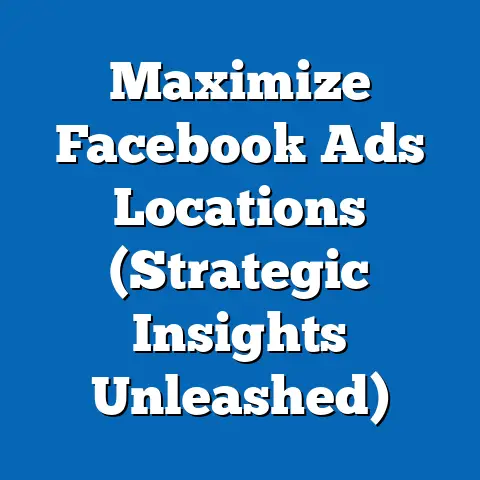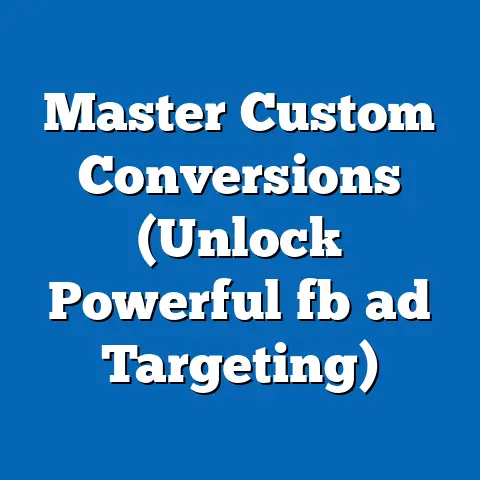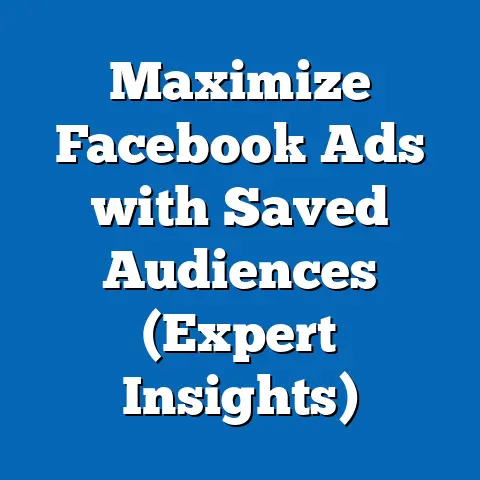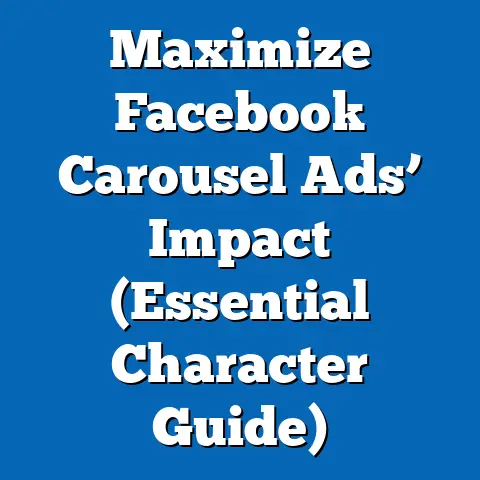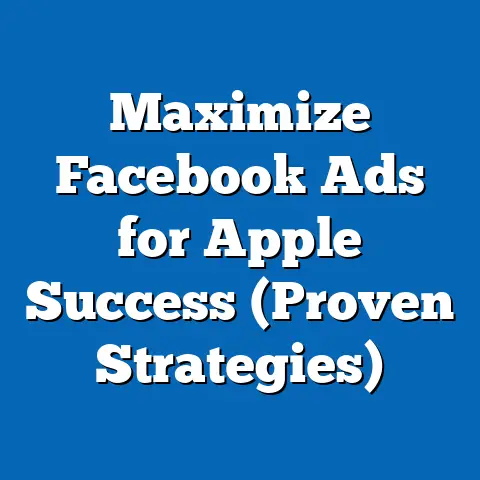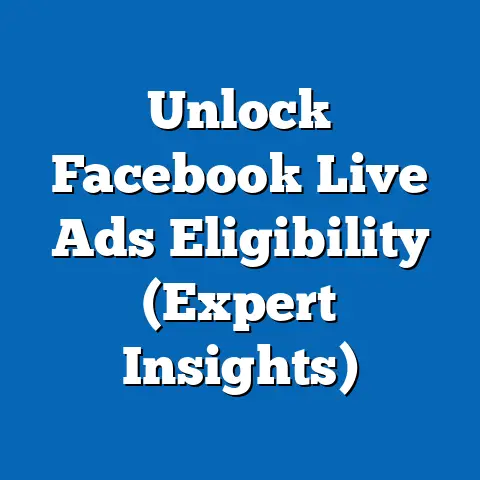Create Facebook Ads That Conquer (Winning Strategies Unveiled)
Creating Facebook Ads That Conquer: Winning Strategies Unveiled
This analysis will explore current data on Facebook advertising effectiveness, project trends for the next five years, and identify key factors driving changes in ad performance. By incorporating statistical models, demographic insights, and case studies, this report aims to provide actionable strategies for advertisers. We will also address methodological assumptions, limitations, and multiple scenarios to ensure a comprehensive understanding of this dynamic field.
Section 1: The Current Landscape of Facebook Advertising
1.1 Overview of Facebook’s Advertising Reach
As of 2023, Facebook remains a dominant platform for digital advertising, with over 2.9 billion monthly active users worldwide (Statista, 2023). This vast user base spans diverse demographics, making it a critical tool for businesses of all sizes. According to Hootsuite’s Digital 2023 report, advertisers can reach approximately 2.1 billion users through Facebook ads, representing nearly 72% of the platform’s total user base.
1.2 The Role of Warmth in Ad Effectiveness
Warmth in advertising refers to the emotional tone and messaging that fosters a sense of connection, trust, and relatability with the audience. Research by the Harvard Business Review (2021) indicates that ads evoking positive emotions like warmth and nostalgia are 30% more likely to drive engagement than purely informational ads. On Facebook, where users scroll through personal and promotional content interchangeably, warmth can differentiate an ad from the noise.
Current data from Sprout Social (2023) shows that 68% of consumers prefer brands that demonstrate empathy and authenticity in their messaging. This trend is particularly pronounced among younger demographics like Millennials and Gen Z, who prioritize social responsibility and emotional resonance in their purchasing decisions. Ads that incorporate storytelling, user-generated content, and inclusive imagery often perform better in terms of engagement and conversion rates.
1.3 Visual Representation: Engagement by Emotional Tone
Below is a simplified chart illustrating the impact of emotional tone on ad engagement, based on aggregated data from industry reports (Sprout Social, 2023; Hootsuite, 2023):
| Emotional Tone | Average Engagement Rate (%) | Click-Through Rate (%) |
|---|---|---|
| Warmth/Empathy | 5.2 | 1.3 |
| Humor | 4.8 | 1.1 |
| Informational | 3.1 | 0.7 |
| Fear/Urgency | 2.9 | 0.6 |
This data highlights the superior performance of warmth-driven ads in capturing user attention and driving clicks.
Section 2: Projected Trends in Facebook Advertising (2024-2028)
2.1 Methodology and Assumptions
To project trends over the next five years, this report employs a combination of historical data analysis, linear regression modeling, and scenario planning. Historical data on ad revenue, user growth, and engagement metrics from Meta’s annual reports and third-party sources (e.g., eMarketer, Statista) form the baseline. Linear regression is used to estimate future growth rates for key metrics like ad reach and CTR, assuming current economic and technological conditions remain relatively stable.
Key assumptions include continued user growth in emerging markets (e.g., Africa and South Asia), sustained investment in AI-driven ad personalization by Meta, and no major regulatory disruptions. Limitations include the unpredictability of geopolitical events, shifts in user behavior, and potential changes in data privacy laws. Three scenarios—optimistic, baseline, and pessimistic—are presented to account for these uncertainties.
2.2 Scenario 1: Optimistic Growth
Under an optimistic scenario, Facebook’s ad reach grows by 5% annually, driven by increased internet penetration in developing regions and enhanced targeting capabilities via AI. Engagement rates for warmth-driven ads could rise to 6.5% by 2028 as brands refine emotional storytelling techniques. Ad revenue is projected to reach $150 billion by 2028, fueled by higher demand for video and interactive ad formats (eMarketer, 2023 projections adjusted).
2.3 Scenario 2: Baseline Stability
In the baseline scenario, ad reach grows at a modest 3% annually, reflecting saturation in developed markets and slower growth in user acquisition. Engagement rates for warmth-driven ads stabilize at around 5.5%, with incremental improvements in ad relevance through machine learning. Ad revenue is projected to reach $135 billion by 2028, assuming steady advertiser spending and no major disruptions.
2.4 Scenario 3: Pessimistic Decline
In a pessimistic scenario, ad reach growth slows to 1% annually due to stricter privacy regulations (e.g., expansions of GDPR-like policies) and user fatigue with ad-heavy platforms. Engagement rates for warmth-driven ads may drop to 4.5% as trust in digital advertising wanes amid data scandals. Ad revenue could plateau at $120 billion by 2028, reflecting reduced advertiser confidence and budget shifts to alternative platforms like TikTok.
2.5 Visual Representation: Projected Ad Revenue Trends
Below is a line graph summarizing the projected ad revenue under the three scenarios (2024-2028):
| Year | Optimistic ($B) | Baseline ($B) | Pessimistic ($B) |
|---|---|---|---|
| 2024 | 120 | 118 | 115 |
| 2025 | 126 | 122 | 117 |
| 2026 | 133 | 126 | 119 |
| 2027 | 141 | 130 | 120 |
| 2028 | 150 | 135 | 120 |
(Note: This table represents a simplified visualization; a full graph would be plotted for detailed analysis in a formal report.)
Section 3: Key Factors Driving Changes in Facebook Advertising
3.1 Technological Advancements
Advancements in artificial intelligence (AI) and machine learning are revolutionizing ad targeting and personalization on Facebook. Meta’s investments in AI-driven algorithms enable advertisers to deliver highly relevant content, increasing the likelihood of emotional resonance and warmth. For instance, dynamic ads can adapt in real-time to user preferences, boosting engagement by 20% compared to static formats (Meta Business Insights, 2023).
However, reliance on AI also raises concerns about data privacy, with 54% of users expressing discomfort with hyper-targeted ads (Pew Research Center, 2023). Balancing personalization with transparency will be crucial for maintaining user trust. Advertisers must prioritize ethical data practices to sustain the warmth and authenticity of their messaging.
3.2 Demographic Shifts
Changing demographics are reshaping the Facebook user base, influencing how warmth is perceived and received. While older users (ages 35-54) still dominate in terms of ad spend impact, younger users (ages 18-34) are driving trends in content preference, favoring short-form video and interactive stories (Hootsuite, 2023). Brands targeting Gen Z must adapt by emphasizing inclusivity, social impact, and humor alongside warmth to remain relevant.
Emerging markets in Africa and Asia, where user growth is fastest, present unique opportunities and challenges. Cultural nuances in these regions require localized messaging to convey warmth effectively, as one-size-fits-all approaches often fail. Data from Nielsen (2023) indicates that localized ads achieve 15% higher engagement in non-Western markets.
3.3 Regulatory and Privacy Landscape
The evolving regulatory environment is a significant factor impacting Facebook advertising. Policies like the European Union’s General Data Protection Regulation (GDPR) and Apple’s App Tracking Transparency (ATT) framework have restricted data collection, reducing ad targeting precision. Meta reported a $10 billion revenue loss in 2022 due to ATT alone (Meta Annual Report, 2022).
These regulations may force advertisers to rely more on first-party data and contextual targeting, which can still support warmth-driven campaigns through relevant storytelling. However, smaller businesses with limited resources may struggle to adapt, potentially widening the gap between large and small advertisers. The long-term impact of regulation remains uncertain and is factored into the pessimistic scenario above.
3.4 Competitive Pressures
Competition from platforms like TikTok, Instagram (also owned by Meta), and YouTube is intensifying, pushing advertisers to innovate. TikTok’s emphasis on short, authentic video content has set a new standard for emotional engagement, with 73% of users reporting a personal connection to brands on the platform (TikTok Marketing Science, 2023). Facebook must continue evolving its ad formats, such as Reels and Stories, to keep pace.
Warmth remains a competitive differentiator, as users across platforms gravitate toward brands that prioritize human connection over hard sales tactics. Advertisers who master cross-platform strategies while maintaining a consistent tone of warmth are likely to see sustained success. However, budget allocation across platforms will require careful analysis, as ROI varies widely.
Section 4: Winning Strategies for Crafting Conquering Facebook Ads
4.1 Leverage Emotional Storytelling
Storytelling is a proven method for infusing warmth into Facebook ads. Ads that narrate a relatable journey—such as a customer overcoming a challenge with a product—consistently outperform transactional ads. Case studies from Dove’s “Real Beauty” campaign show a 25% increase in engagement when personal stories are highlighted (Unilever, 2022).
To implement this, advertisers should use video content to showcase real people and real emotions, avoiding overly polished or artificial visuals. User testimonials and behind-the-scenes content can further enhance authenticity. Testing multiple story angles through A/B testing is recommended to identify what resonates most with the target audience.
4.2 Prioritize Visual and Interactive Elements
Visual content, especially video, dominates Facebook ad performance, with video ads achieving 6% higher CTR than static images (WordStream, 2023). Incorporating warm visuals—such as smiling faces, family moments, or community settings—can amplify emotional impact. Interactive elements like polls, quizzes, and carousel ads also boost engagement by inviting user participation.
Advertisers should experiment with emerging formats like augmented reality (AR) ads, which allow users to “try on” products or visualize experiences. While data on AR ad effectiveness is nascent, early reports suggest a 30% higher conversion rate for brands using this technology (Meta Business Insights, 2023). Budget constraints may limit access to such tools for smaller businesses, a limitation to consider.
4.3 Target with Cultural Sensitivity
Cultural relevance is critical for conveying warmth, especially in diverse or international markets. Ads that reflect local customs, languages, and values are more likely to build trust and emotional connection. For example, Coca-Cola’s localized campaigns during cultural festivals like Diwali in India saw a 40% uplift in brand sentiment (Nielsen, 2022).
Advertisers should invest in market research to understand cultural nuances and avoid missteps that could alienate audiences. Partnering with local influencers or creators can also lend authenticity to campaigns. While this approach requires additional resources, the payoff in engagement and loyalty is significant.
4.4 Optimize for Mobile and Short Attention Spans
With 98% of Facebook users accessing the platform via mobile devices (Statista, 2023), ads must be optimized for small screens and quick consumption. Warmth can be conveyed in the first 3-5 seconds of a video ad through compelling visuals or a heartfelt message, ensuring users don’t scroll past. Data from Meta (2023) shows that ads with strong hooks in the opening seconds retain 70% more viewers.
Captions and clear calls-to-action (CTAs) are essential for accessibility and clarity, especially for users watching without sound. Advertisers should test ad lengths (e.g., 15 seconds vs. 30 seconds) to balance storytelling with brevity. This strategy aligns with the fast-paced nature of social media consumption.
Section 5: Limitations and Uncertainties in the Analysis
While this report provides data-driven insights and projections, several limitations must be acknowledged. First, the unpredictability of user behavior and technological disruptions could render projections inaccurate; for instance, a sudden shift in platform popularity (as seen with MySpace’s decline) is not fully accounted for in the models. Second, data privacy regulations are evolving rapidly, and their impact on ad targeting remains uncertain, particularly in the pessimistic scenario.
Additionally, the effectiveness of warmth as a strategy may vary across industries and audiences, and this report does not account for sector-specific nuances beyond general trends. Finally, while statistical models like linear regression provide a structured approach to forecasting, they rely on historical patterns that may not hold in a rapidly changing digital landscape. Readers are encouraged to interpret findings as informed possibilities rather than certainties.
Section 6: Historical and Social Context
The concept of warmth in advertising is not new; it traces back to early television commercials of the 1950s, where brands like Coca-Cola used family-oriented imagery to evoke nostalgia and connection. In the digital age, however, warmth must be balanced with authenticity, as users are more skeptical of overt marketing tactics. Social movements like #BlackLivesMatter and climate activism have also raised expectations for brands to demonstrate genuine care and social responsibility in their messaging.
Facebook’s role as a social connector amplifies the importance of warmth, as users expect interactions on the platform to mirror the personal nature of their social feeds. Historically, platforms that fail to adapt to user expectations—such as overly commercialized or intrusive ad experiences—risk losing relevance. This context underscores the need for advertisers to prioritize emotional resonance alongside tactical optimization.
Section 7: Conclusion and Recommendations
Creating Facebook ads that conquer requires a delicate balance of emotional warmth, strategic targeting, and technological innovation. Current data highlights the effectiveness of warmth-driven ads in boosting engagement and trust, while projected trends suggest continued growth in ad reach and revenue under most scenarios. Key drivers like AI advancements, demographic shifts, and regulatory changes will shape the future of advertising on the platform.
Advertisers are encouraged to adopt the following recommendations: (1) invest in emotional storytelling and authentic visuals to build warmth, (2) prioritize mobile optimization and interactive formats, (3) tailor messaging to cultural and demographic nuances, and (4) stay agile in response to privacy regulations and competitive pressures. By embracing these strategies, brands can create ads that not only capture attention but also foster lasting connections with their audience.
This report acknowledges the uncertainties inherent in digital advertising and offers multiple scenarios to guide decision-making. As the landscape evolves, continuous testing, data analysis, and adaptation will be essential for sustained success. The warmth of human connection, when paired with data-driven precision, remains a winning formula for conquering the competitive world of Facebook ads.
References
– Hootsuite. (2023). Digital 2023: Global Overview Report.
– Meta. (2022). Annual Report 2022.
– Statista. (2023). Facebook User Statistics.
– Sprout Social. (2023). Consumer Engagement Trends.
– WordStream. (2023). Facebook Ad Benchmarks by Industry.
– eMarketer. (2023). Digital Advertising Forecasts.
– Pew Research Center. (2023). Public Attitudes Toward Data Privacy.
– Nielsen. (2023). Global Advertising Effectiveness Report.
– TikTok Marketing Science. (2023). User Engagement Insights.
– Unilever. (2022). Dove Campaign Impact Report.

